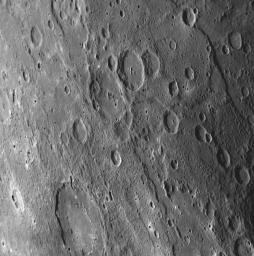A Long Scarp Revisited
Caption:
Seventy-four minutes before closest approach during MESSENGER's third Mercury flyby, the NAC captured this image as part of a 62-image high-resolution
mosaic
of the
sunlit crescent
. A feature of particular interest in this image is the prominent scarp cutting across the upper right corner, with a crater ~30 kilometers (19 miles) in diameter overlying the scarp. This ~480-kilometer-long (300-mile-long) scarp was also imaged during Mercury flyby 2 (
PIA11370
), though during that encounter the scarp was positioned much closer to the limb of the planet. Imaging the same feature from different viewing geometries during Mercury flybys 2 and 3 enabled the creation of a three dimensional view of this scarp, similar to that shown in this released image of
Rembrandt basin
. Having such views provides information on the topographic relief of surface features on Mercury. A topographic profile of this scarp was also made by the Mercury Laser Altimeter during MESSENGER's first Mercury flyby. That profile, obtained north of the superposed impact crater, shows that the scarp exhibits 1.4 kilometers (0.9 miles) of topographic relief.
Date Acquired:
September 29, 2009
Image Mission Elapsed Time (MET):
162744258
Instrument:
Narrow Angle Camera (NAC) of the Mercury Dual Imaging System (MDIS)
Resolution:
400 meters/pixel (0.25 miles/pixel)
Scale:
This image is about 410 kilometers (250 miles) from top to bottom
Spacecraft Altitude:
15,300 kilometers (9,500 miles)
Background Info:
These images are from MESSENGER, a NASA Discovery mission to conduct the first orbital study of the innermost planet, Mercury. For information regarding the use of images, see the MESSENGER
image use policy
.
Cataloging Keywords:
| Name |
Value |
Additional Values |
| Target |
Mercury |
|
| System |
|
|
| Target Type |
Planet |
|
| Mission |
MESSENGER |
|
| Instrument Host |
MESSENGER |
|
| Host Type |
Orbiter |
|
| Instrument |
Mercury Dual Imaging System (MDIS) |
|
| Detector |
Narrow Angle Camera (NAC) |
|
| Extra Keywords |
Crater, Grayscale, Impact |
| Acquisition Date |
|
| Release Date |
2009-11-24 |
| Date in Caption |
2009-09-29 |
|
| Image Credit |
NASA/Johns Hopkins University Applied Physics Laboratory/Carnegie Institution of Washington |
| Source |
photojournal.jpl.nasa.gov/catalog/PIA12379 |
| Identifier |
PIA12379 |

 Planetary Data System
Planetary Data System
